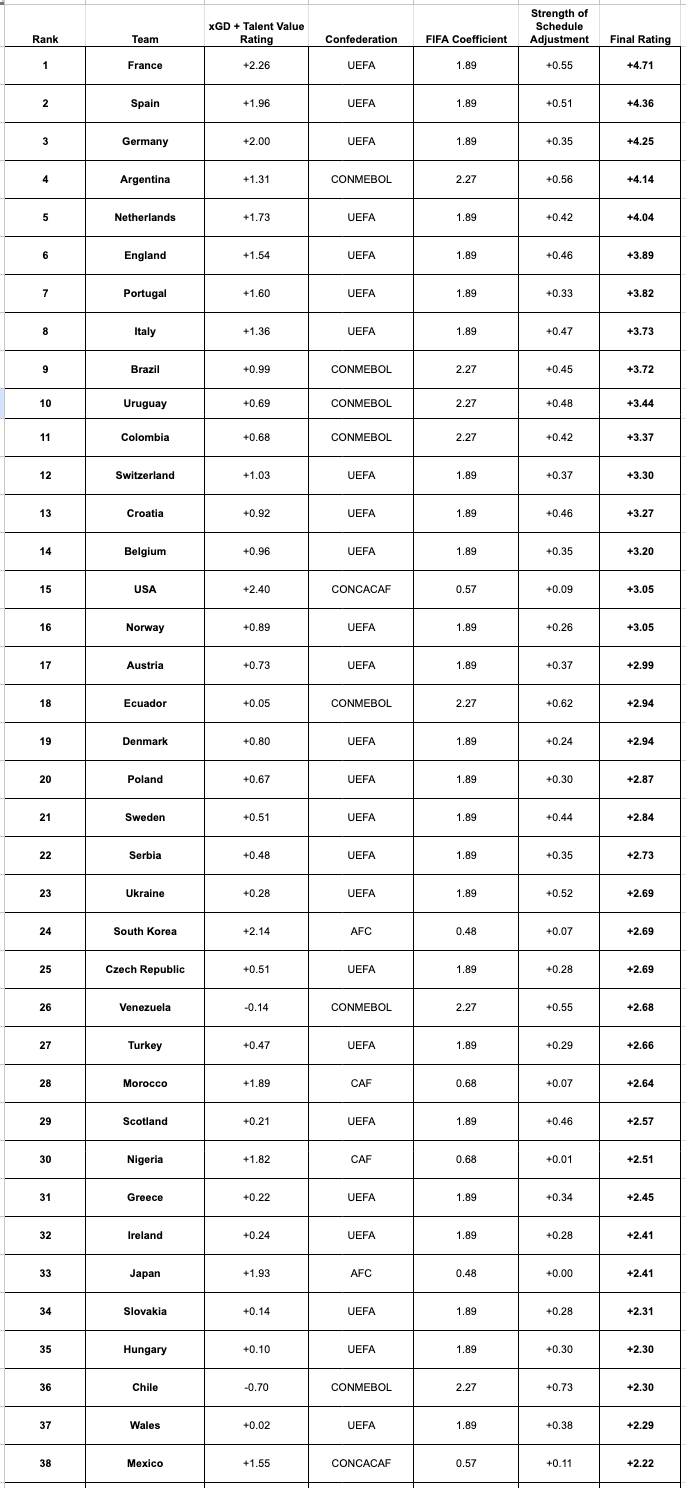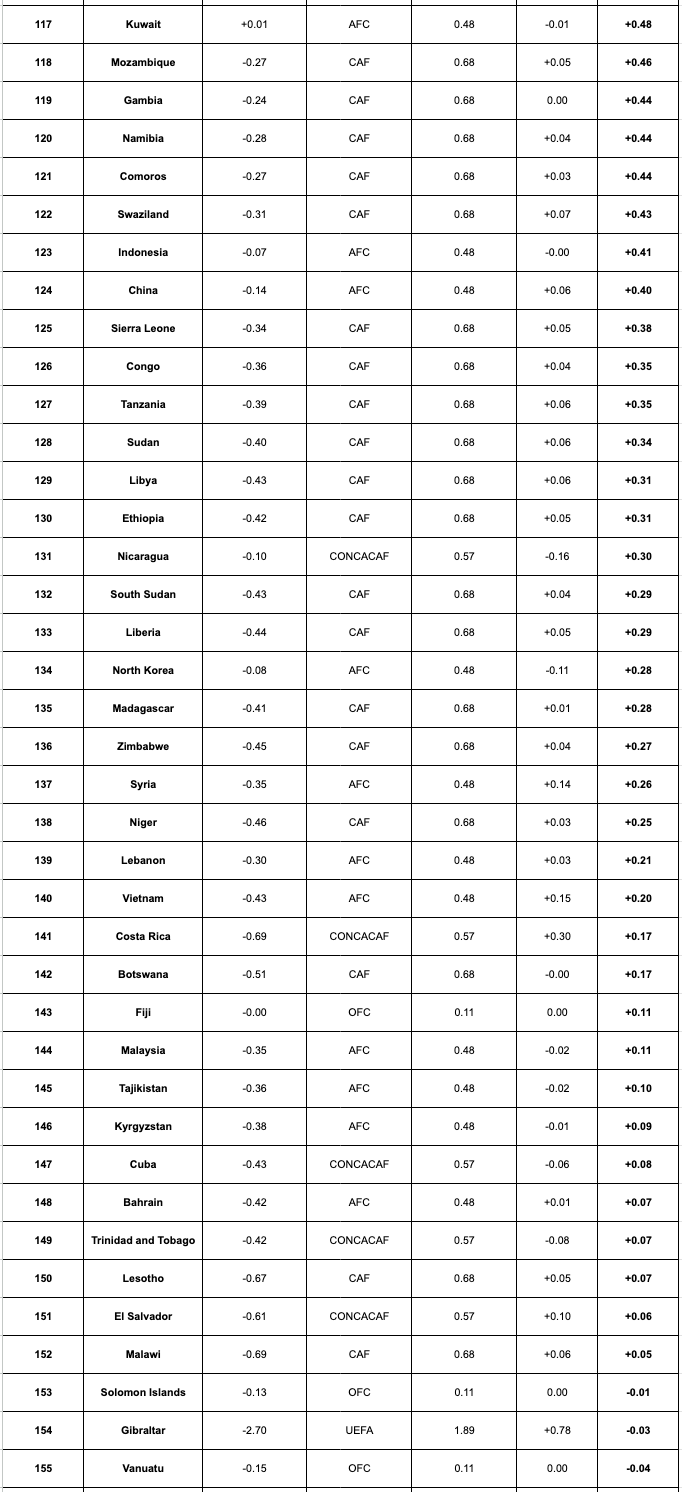Purpose of these rankings
A while ago, I took on a project of trying to rank all of the international teams in the world. The reason I decided to do it is because I thought the FIFA rankings were flawed. They are “results” based rankings, which when we are trying to answer the question “How good is X team” that is not the right way to approach it.
For example, if an incredibly talented team gets bounced in the group stage of a tournament because they got caught on the wrong side of variance, they drop in the rankings. Conversely, if a less talented team goes on a crazy run of upsets, but gets incredibly lucky along the way, they move up in the FIFA rankings.
Of course, these rankings are designed to be who is most “deserving” by a matter of results and the level opponent you face. Instead, my rankings are more along the lines of “Power Rankings” using four factors that I will discuss below.
Four Factors Determining Rankings
1) Expected Goals Results
Expected goals are the best way to measure how good a team is over the long run. Of course, single match xG requires context, but a teams underyling metrics are a way better indicator that actual goals scored and conceded.
Expected Goals or (xG) measure the quality of a chance by calculating the likelihood that it will be scored from a particular position on the pitch during a particular phase of play. This value is based on several factors from before the shot was taken. xG is measured on a scale between zero and one, where zero represents a chance that is impossible to score and one represents a chance that a player would be expected to score every single time.
I have gone through and logged every country's expected goals results, but only from competitive competitions. Friendlies and Nations League are not included.
Note: All xG results are from matches in the competitions listed below that have occurred from January 1st 2022 until today.
Here are the following competitions that are included for each confederation:
UEFA (Europe)
European Championship Qualifiers
European Championships
World Cup Qualifiers
CONMEBOL (South America)
Copa America
World Cup Qualifiers
CONCACAF (North America)
Gold Cup
World Cup Qualifiers
Copa America
CAF (Africa)
Africa Cup of Nations Qualifiers
World Cup Qualifiers
Africa Cup of Nations
AFC (Asia)
World Cup Qualifiers
Asian Cup
OFC (Ocenia)
World Cup Qualifiers
World Cup
2) Transfer Value Adjustment
I use Michael Caley’s method of using a team's overall transfer value to account for the talent level of each country.
Using Transfermarkt data and running a few different calculations, these are the top 25 countries based on total transfer-market value, along with the amount added or subtracted (if the countries total transfer value is below the world average) to their xG differential to help determine the overall rating.
*(data via transfermarkt.com)
3) FIFA Coefficients
Similar to the idea of UEFA Coefficients, which help determine how many teams each country can get into the Champions League, Europa League and Europa Conference League, I decided to put a coefficient on each continent.
UEFA Coefficients are determined by how well the club teams from each country do in European competitions.
So, I applied that same method to FIFA Coefficients by going back through the last five World Cup competitions and gave out point values (based on the criteria below), along with a weight for the average transfer value by continent to get to a value that can be added to each country's rating based on what continent it resides in.
FIFA Coefficient Points:
Two points: For all wins in the group stage & knockout stage
One point: For all draws in the group stage
Two points: Bonus for finishing second in the group
Four points: Bonus for winning the group
One point: Bonus for each round reach from the Round 16 onward
After some calculations, here are the following "FIFA Coefficients" that are added to each country's xG differential plus transfer value adjustment:
As you can see, Europe and South America are weighted far greater than the rest of the world, which makes sense considering they are the two continents that dominate international football
4) Strength of Schedule
Strength of Schedule needs to be taken into account when determining rankings like this:
Worldwide
Even though FIFA coefficients can give us a good weight for each continent's true level of play, another strength of schedule at the world level is necessary to properly rate each country.
So, there's a "final ranking before strength of schedule adjustment," which is the Final rating after taking into account xGDiff plus transfer value adjustment plus a strength of schedule adjustment.
The strength of schedule adjustment is done by taking the average worldwide strength of schedule divided by the average rank of opponents faced minus 100 percent.
After all of that, we reach the final rating for each country, which is:
Final Rating = xGDiff per match + transfer value adjustment + FIFA coefficient + strength of schedule adjustment.
Note: I don’t have access to data for Oceania teams, so they’re ranked based on their Transfer Value.












